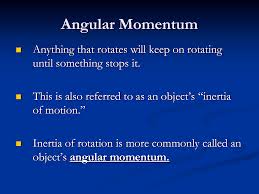Overview
Any spinning object rotates around a central point called an axis. Tops, dreidels, gyroscopes, and spinning eggs rotate, rise, and seem to defy gravity, as long as they are moving. When they stop moving, they fall.
Angular Momentum
Angular momentum refers to movement in a circle rather than a straight line. Imagine the movement of one dot on the spinning object as it twirls (such as one dot above the right of the Hebrew letter shin). Its path could be described by angular momentum around the axis through the point of support. The equation that describes angular momentum L takes into account its mass, shape, and rate of speed. In this equation, L = Iω, means that angular momentum is the product of an object’s inertia, or resistance to change in its velocity, times its angular (or circular) velocity ω.
Conservation of Angular Momentum
Many spinning objects tend to conserve angular momentum. Imagine a figure skater entering a spin. She brings her arms close to her body, spinning faster and faster, and is able to keep balance partly because of angular momentum (and a lot of practice). A rigid object, such as a sphere, will remain upright as it spins on an axis because angular momentum is conserved as long as it is spinning. The system is effectively closed due to Newtonian laws of motion, and can be described in terms of relationships between derivatives.
Precession
As a top, planet, or gyroscope spins, its axis does not stay at a fixed point. It tilts and rolls. Precession depends upon whether a force, known as torque, is applied to the spinning object, and how much force is applied. Similar to the equations describing angular momentum, the equations that describe precession also use inertia, rate of speed around the axis, and angle between the symmetry axis and direction of inertia.
Gyroscopes, Tops, and Spinning Eggs
Gyroscopes are self-balancing, and have been used since the 18th century in compasses, navigational tools, and in toys. They use general principles of three axes: pitch, roll, and yaw in order to plot precise position in space. Tops have been used as toys in cultures from ancient China and India to Greece and Rome. Spinning eggs and some types of tops actually change axes as they swirl and slow down. All spinning objects rely on similar principles, involving angular momentum, precession, and inertia.
Interested in math and physics tutoring services? Learn more about how we are assisting thousands of students each academic year.
SchoolTutoring Academy is the premier educational services company for K-12 and college students. We offer tutoring programs for students in K-12, AP classes, and college. To learn more about how we help parents and students in Bismarck, ND: visit: Tutoring in Bismarck, ND



